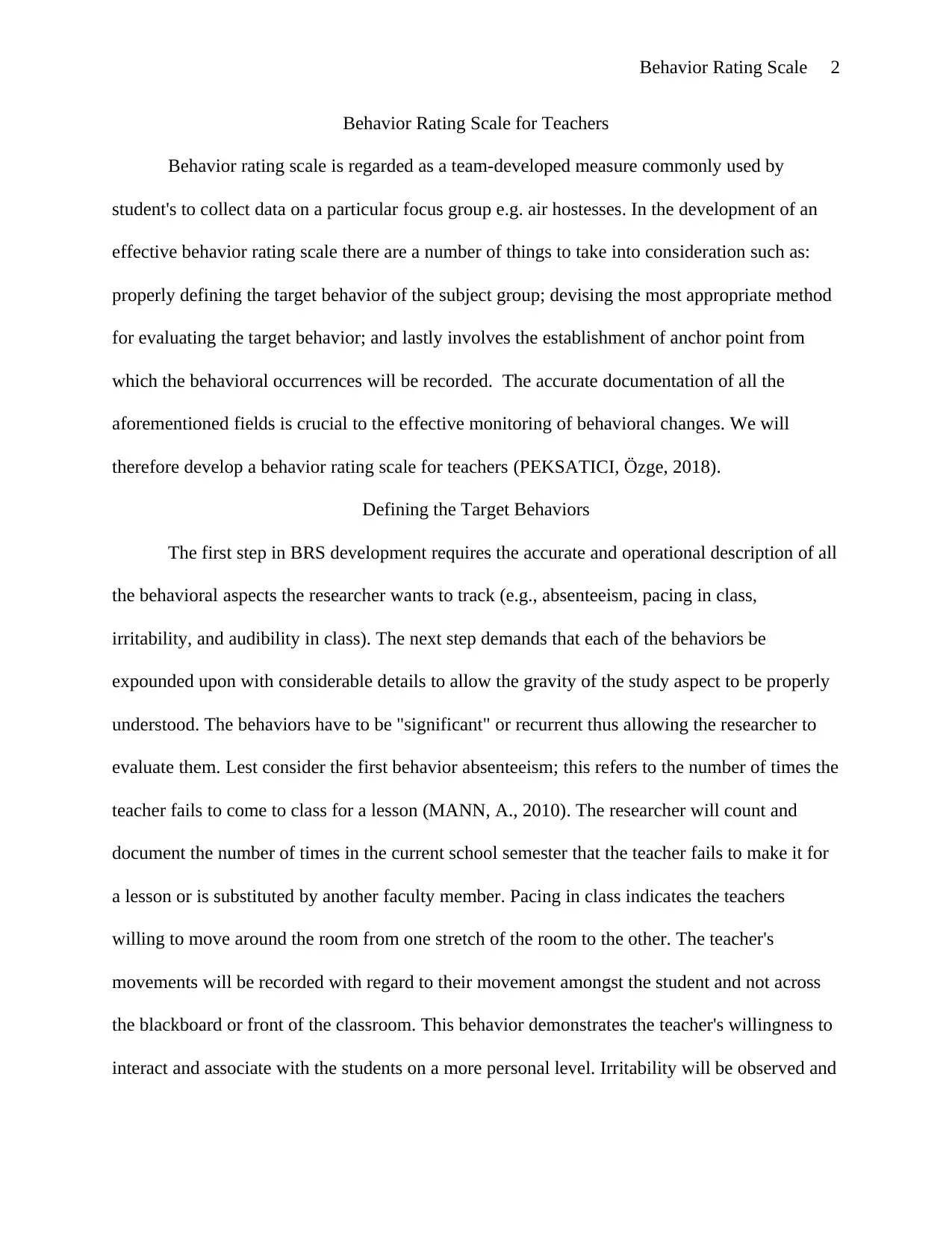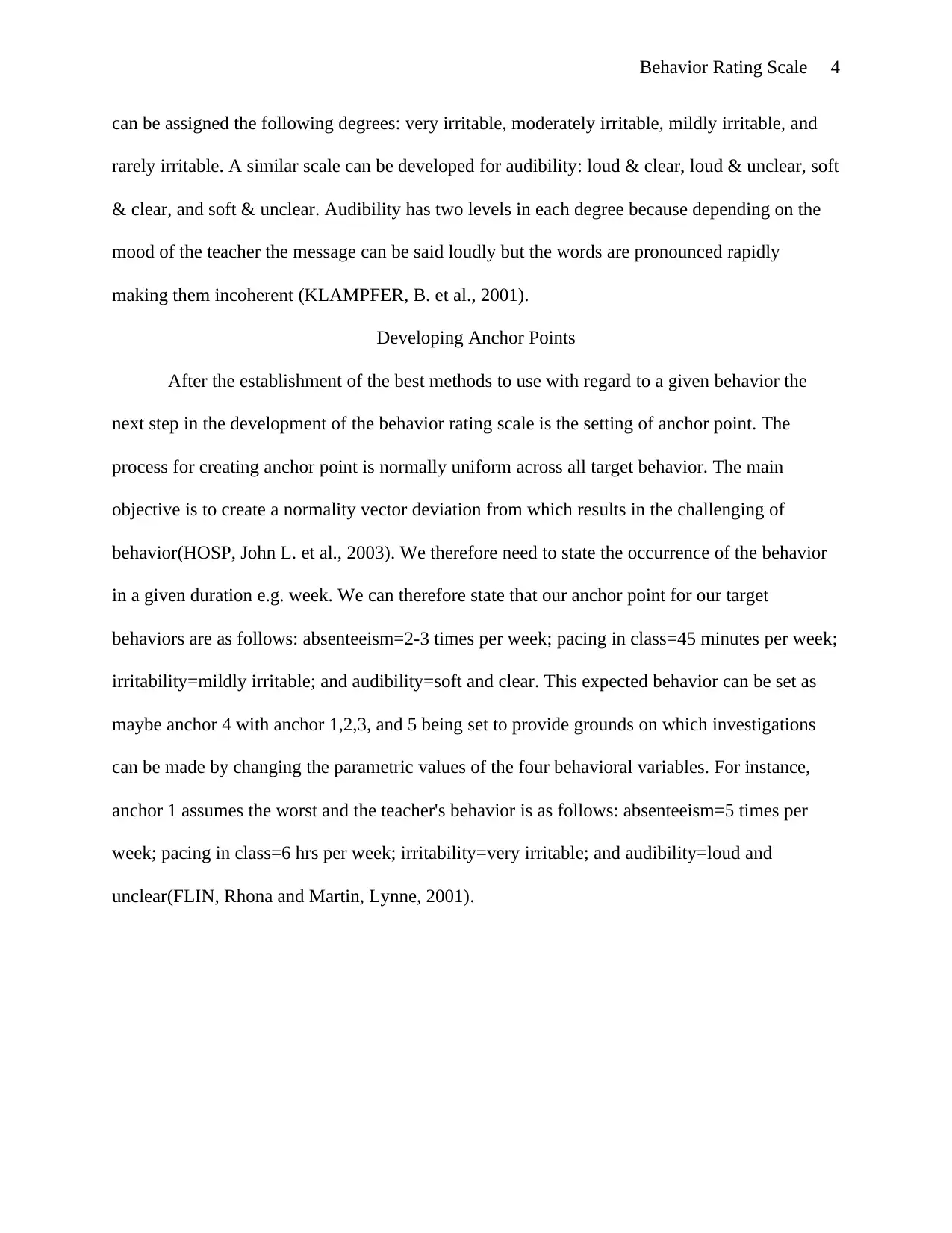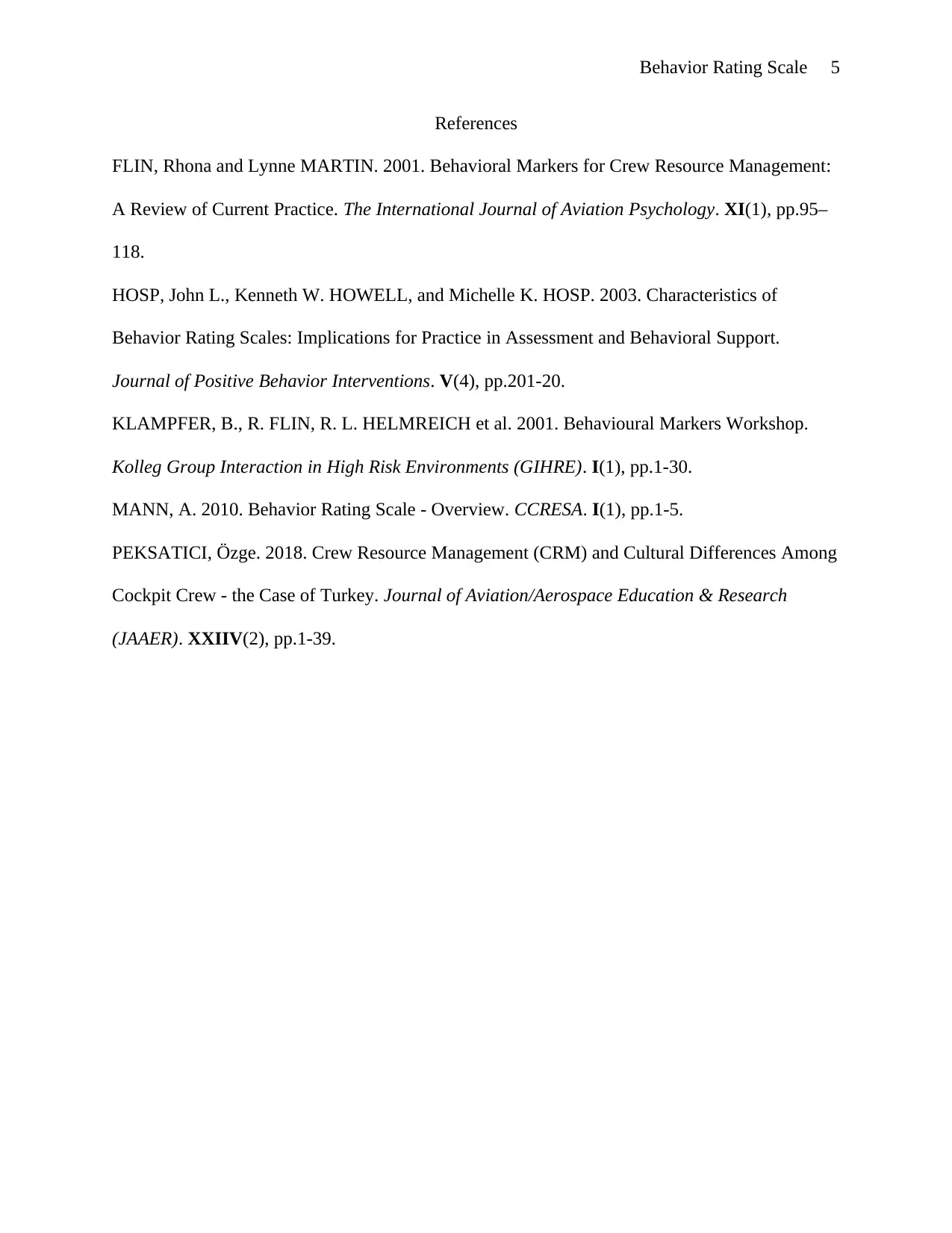University Report: Behavior Rating Scale Development for Educators
VerifiedAdded on 2023/06/03
|5
|1290
|280
Report
AI Summary
This report details the development of a behavior rating scale (BRS) tailored for teachers, encompassing crucial aspects of classroom conduct and performance evaluation. The report begins by emphasizing the importance of defining specific target behaviors, such as teacher absenteeism, pacing in the classroom, irritability levels, and audibility of voice, providing clear operational definitions for each. It then explores various measurement methods best suited for each behavior, including frequency, duration, and intensity scales, alongside the establishment of anchor points to standardize observations. The BRS framework enables the researcher to systematically document and assess behavioral changes over time. The report delves into the practical application of these methods, using examples to illustrate how the scale can be used to evaluate and monitor teacher performance, ultimately aiming to offer a structured approach for improving teaching practices and classroom management.

Behavior Rating Scale 1
BEHAVIOR RATING SCALE FOR TEACHERS
By (Name)
The Name of the Class (Course)
Professor (Tutor)
The Name of the School (University)
The City and State where it is located
The Date
BEHAVIOR RATING SCALE FOR TEACHERS
By (Name)
The Name of the Class (Course)
Professor (Tutor)
The Name of the School (University)
The City and State where it is located
The Date
Paraphrase This Document
Need a fresh take? Get an instant paraphrase of this document with our AI Paraphraser

Behavior Rating Scale 2
Behavior Rating Scale for Teachers
Behavior rating scale is regarded as a team-developed measure commonly used by
student's to collect data on a particular focus group e.g. air hostesses. In the development of an
effective behavior rating scale there are a number of things to take into consideration such as:
properly defining the target behavior of the subject group; devising the most appropriate method
for evaluating the target behavior; and lastly involves the establishment of anchor point from
which the behavioral occurrences will be recorded. The accurate documentation of all the
aforementioned fields is crucial to the effective monitoring of behavioral changes. We will
therefore develop a behavior rating scale for teachers (PEKSATICI, Özge, 2018).
Defining the Target Behaviors
The first step in BRS development requires the accurate and operational description of all
the behavioral aspects the researcher wants to track (e.g., absenteeism, pacing in class,
irritability, and audibility in class). The next step demands that each of the behaviors be
expounded upon with considerable details to allow the gravity of the study aspect to be properly
understood. The behaviors have to be "significant" or recurrent thus allowing the researcher to
evaluate them. Lest consider the first behavior absenteeism; this refers to the number of times the
teacher fails to come to class for a lesson (MANN, A., 2010). The researcher will count and
document the number of times in the current school semester that the teacher fails to make it for
a lesson or is substituted by another faculty member. Pacing in class indicates the teachers
willing to move around the room from one stretch of the room to the other. The teacher's
movements will be recorded with regard to their movement amongst the student and not across
the blackboard or front of the classroom. This behavior demonstrates the teacher's willingness to
interact and associate with the students on a more personal level. Irritability will be observed and
Behavior Rating Scale for Teachers
Behavior rating scale is regarded as a team-developed measure commonly used by
student's to collect data on a particular focus group e.g. air hostesses. In the development of an
effective behavior rating scale there are a number of things to take into consideration such as:
properly defining the target behavior of the subject group; devising the most appropriate method
for evaluating the target behavior; and lastly involves the establishment of anchor point from
which the behavioral occurrences will be recorded. The accurate documentation of all the
aforementioned fields is crucial to the effective monitoring of behavioral changes. We will
therefore develop a behavior rating scale for teachers (PEKSATICI, Özge, 2018).
Defining the Target Behaviors
The first step in BRS development requires the accurate and operational description of all
the behavioral aspects the researcher wants to track (e.g., absenteeism, pacing in class,
irritability, and audibility in class). The next step demands that each of the behaviors be
expounded upon with considerable details to allow the gravity of the study aspect to be properly
understood. The behaviors have to be "significant" or recurrent thus allowing the researcher to
evaluate them. Lest consider the first behavior absenteeism; this refers to the number of times the
teacher fails to come to class for a lesson (MANN, A., 2010). The researcher will count and
document the number of times in the current school semester that the teacher fails to make it for
a lesson or is substituted by another faculty member. Pacing in class indicates the teachers
willing to move around the room from one stretch of the room to the other. The teacher's
movements will be recorded with regard to their movement amongst the student and not across
the blackboard or front of the classroom. This behavior demonstrates the teacher's willingness to
interact and associate with the students on a more personal level. Irritability will be observed and

Behavior Rating Scale 3
documented will regard of how often and to what extent the teacher is angered or frustrated by
something that the students are doing. This measure indicates the teacher's level of endurance
and perseverance when student fail to do what they are told or they are unable to complete a
given task. Lastly, audibility relates to the ability of the teacher to clearly project his/her voice
well enough that all the individuals in the class room are able to under what he/she is saying.
This behavior can be used to tell the teachers' mood and frame of mind; because some teachers
are only audible when they are anger or aggravated (MANN, A., 2010).
Methods of Measurement
The next step in formulating the behavior rating scale requires the development of a
feasible and effective measurement method for the behaviors stated. The researcher can state by
asking him/herself the following questions: which is the easiest method that can be used to
measure the behavior, and which measure will best capture the significance of the target
behaviors (intensity, frequency, or duration). Absenteeism of the teacher during a lesson can be
viewed as a discreet variable that assumes positive whole numbers. As such, measuring the
frequency is the best method to employ for this target behavior (MANN, A., 2010). The
researcher will therefore be required to simply note down the number of missed lessons (on the
teacher's part) within a given semester. With regard to the behavior of pacing around the class,
the action does not a defined start or end point therefore it is not discreet. As such, it is seen as a
repetition of a given behavior i.e. pacing in class. For such a behavior, the researcher will use a
measure of duration and recorded the period over which the teacher paced around the class e.g. 3
minutes. And lastly, for the behavior of audibility and irritability a measure of intensity will be
used as the most appropriate method. This approach demands the definition of the various
degrees of intensity that can be associated with that particular behavior. For instance, irritability
documented will regard of how often and to what extent the teacher is angered or frustrated by
something that the students are doing. This measure indicates the teacher's level of endurance
and perseverance when student fail to do what they are told or they are unable to complete a
given task. Lastly, audibility relates to the ability of the teacher to clearly project his/her voice
well enough that all the individuals in the class room are able to under what he/she is saying.
This behavior can be used to tell the teachers' mood and frame of mind; because some teachers
are only audible when they are anger or aggravated (MANN, A., 2010).
Methods of Measurement
The next step in formulating the behavior rating scale requires the development of a
feasible and effective measurement method for the behaviors stated. The researcher can state by
asking him/herself the following questions: which is the easiest method that can be used to
measure the behavior, and which measure will best capture the significance of the target
behaviors (intensity, frequency, or duration). Absenteeism of the teacher during a lesson can be
viewed as a discreet variable that assumes positive whole numbers. As such, measuring the
frequency is the best method to employ for this target behavior (MANN, A., 2010). The
researcher will therefore be required to simply note down the number of missed lessons (on the
teacher's part) within a given semester. With regard to the behavior of pacing around the class,
the action does not a defined start or end point therefore it is not discreet. As such, it is seen as a
repetition of a given behavior i.e. pacing in class. For such a behavior, the researcher will use a
measure of duration and recorded the period over which the teacher paced around the class e.g. 3
minutes. And lastly, for the behavior of audibility and irritability a measure of intensity will be
used as the most appropriate method. This approach demands the definition of the various
degrees of intensity that can be associated with that particular behavior. For instance, irritability
⊘ This is a preview!⊘
Do you want full access?
Subscribe today to unlock all pages.

Trusted by 1+ million students worldwide

Behavior Rating Scale 4
can be assigned the following degrees: very irritable, moderately irritable, mildly irritable, and
rarely irritable. A similar scale can be developed for audibility: loud & clear, loud & unclear, soft
& clear, and soft & unclear. Audibility has two levels in each degree because depending on the
mood of the teacher the message can be said loudly but the words are pronounced rapidly
making them incoherent (KLAMPFER, B. et al., 2001).
Developing Anchor Points
After the establishment of the best methods to use with regard to a given behavior the
next step in the development of the behavior rating scale is the setting of anchor point. The
process for creating anchor point is normally uniform across all target behavior. The main
objective is to create a normality vector deviation from which results in the challenging of
behavior(HOSP, John L. et al., 2003). We therefore need to state the occurrence of the behavior
in a given duration e.g. week. We can therefore state that our anchor point for our target
behaviors are as follows: absenteeism=2-3 times per week; pacing in class=45 minutes per week;
irritability=mildly irritable; and audibility=soft and clear. This expected behavior can be set as
maybe anchor 4 with anchor 1,2,3, and 5 being set to provide grounds on which investigations
can be made by changing the parametric values of the four behavioral variables. For instance,
anchor 1 assumes the worst and the teacher's behavior is as follows: absenteeism=5 times per
week; pacing in class=6 hrs per week; irritability=very irritable; and audibility=loud and
unclear(FLIN, Rhona and Martin, Lynne, 2001).
can be assigned the following degrees: very irritable, moderately irritable, mildly irritable, and
rarely irritable. A similar scale can be developed for audibility: loud & clear, loud & unclear, soft
& clear, and soft & unclear. Audibility has two levels in each degree because depending on the
mood of the teacher the message can be said loudly but the words are pronounced rapidly
making them incoherent (KLAMPFER, B. et al., 2001).
Developing Anchor Points
After the establishment of the best methods to use with regard to a given behavior the
next step in the development of the behavior rating scale is the setting of anchor point. The
process for creating anchor point is normally uniform across all target behavior. The main
objective is to create a normality vector deviation from which results in the challenging of
behavior(HOSP, John L. et al., 2003). We therefore need to state the occurrence of the behavior
in a given duration e.g. week. We can therefore state that our anchor point for our target
behaviors are as follows: absenteeism=2-3 times per week; pacing in class=45 minutes per week;
irritability=mildly irritable; and audibility=soft and clear. This expected behavior can be set as
maybe anchor 4 with anchor 1,2,3, and 5 being set to provide grounds on which investigations
can be made by changing the parametric values of the four behavioral variables. For instance,
anchor 1 assumes the worst and the teacher's behavior is as follows: absenteeism=5 times per
week; pacing in class=6 hrs per week; irritability=very irritable; and audibility=loud and
unclear(FLIN, Rhona and Martin, Lynne, 2001).
Paraphrase This Document
Need a fresh take? Get an instant paraphrase of this document with our AI Paraphraser

Behavior Rating Scale 5
References
FLIN, Rhona and Lynne MARTIN. 2001. Behavioral Markers for Crew Resource Management:
A Review of Current Practice. The International Journal of Aviation Psychology. XI(1), pp.95–
118.
HOSP, John L., Kenneth W. HOWELL, and Michelle K. HOSP. 2003. Characteristics of
Behavior Rating Scales: Implications for Practice in Assessment and Behavioral Support.
Journal of Positive Behavior Interventions. V(4), pp.201-20.
KLAMPFER, B., R. FLIN, R. L. HELMREICH et al. 2001. Behavioural Markers Workshop.
Kolleg Group Interaction in High Risk Environments (GIHRE). I(1), pp.1-30.
MANN, A. 2010. Behavior Rating Scale - Overview. CCRESA. I(1), pp.1-5.
PEKSATICI, Özge. 2018. Crew Resource Management (CRM) and Cultural Differences Among
Cockpit Crew - the Case of Turkey. Journal of Aviation/Aerospace Education & Research
(JAAER). XXIIV(2), pp.1-39.
References
FLIN, Rhona and Lynne MARTIN. 2001. Behavioral Markers for Crew Resource Management:
A Review of Current Practice. The International Journal of Aviation Psychology. XI(1), pp.95–
118.
HOSP, John L., Kenneth W. HOWELL, and Michelle K. HOSP. 2003. Characteristics of
Behavior Rating Scales: Implications for Practice in Assessment and Behavioral Support.
Journal of Positive Behavior Interventions. V(4), pp.201-20.
KLAMPFER, B., R. FLIN, R. L. HELMREICH et al. 2001. Behavioural Markers Workshop.
Kolleg Group Interaction in High Risk Environments (GIHRE). I(1), pp.1-30.
MANN, A. 2010. Behavior Rating Scale - Overview. CCRESA. I(1), pp.1-5.
PEKSATICI, Özge. 2018. Crew Resource Management (CRM) and Cultural Differences Among
Cockpit Crew - the Case of Turkey. Journal of Aviation/Aerospace Education & Research
(JAAER). XXIIV(2), pp.1-39.
1 out of 5
Your All-in-One AI-Powered Toolkit for Academic Success.
+13062052269
info@desklib.com
Available 24*7 on WhatsApp / Email
![[object Object]](/_next/static/media/star-bottom.7253800d.svg)
Unlock your academic potential
Copyright © 2020–2025 A2Z Services. All Rights Reserved. Developed and managed by ZUCOL.